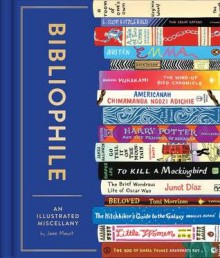

Bibliophile: An Illustrated Miscellany by Jane Mount is a beautifully crafted and charming tribute to the printed book as both a physical object and an enduring cultural contribution. Mount’s delightful illustrations fill every page and are inspired by her prior experience as an artist painting clients’ “Ideal Bookshelves.” This book provides informative and entertaining descriptions of a wide variety of titles, with chapters organized by familiar genres or quirky subjects (e.g.: “Unhappy Families Each in Their Own Way”). Bibliophile focuses primarily on fiction, but some popular nonfiction categories are also presented. Interspersed throughout the book are profiles on bookstores and libraries throughout the world known for their interesting origins, architecture or collections. Author profiles and depictions of their writing spaces give insight into the creative surroundings and inspirations of well-loved classics. Mount steps aside to give plenty of space to include recommendations by other book experts such as librarians, booksellers, editors, and artists. Packed with the advertised “miscellany,” fun trivia and quizzes, this homage would make a wonderful addition to any book aficionado’s shelves, and a great gift for those who still revere the look and feel of this timeless media.

A small, slim tome that is exactly what it says it is: a miscellany of facts about libraries throughout history. Some of it is nothing new to anyone who enjoys a good book about a book, but most of it was new and fairly interesting. It had a few drive-my-husband-crazy moments of "listen to this!" but not so many that there was heavy sighing or eye-rolling going on.
My personal favourites included the most overdue books and the example of rules at different major libraries in the world (I love that the Vatican Library has a bar). I'm dying to know why Portugal's legal deposit laws require 11 copies of every book be submitted (as opposed to the more common 1-2 copies).
I'd have liked to have seen some illustrations of a few of the topics mentioned, but overall it's a nice little book, and one I'll likely refer to more than once when I feel the need to torture friends with book related trivia.

As I found out after reading, this is one of the most famous and most widely-read novels of the first Australian recipient of the Nobel Prize in Literature. Although critically acclaimed abroad it wasn't much of a success in Australia when it first came out in 1955.
It's the slow-paced life story of a good though rather taciturn farmer and his family in the stunning nature of New South Wales in the first half of the twentieth century. Things change all around, the children go their own ways and relations between husband and wife are characterised by affection and habit.
For more be invited to click here and read my long review on my book blog Edith's Miscellany or its duplicate on Read the Nobels!

In spite of its title, the novel The Loving Spirit isn’t just another one of those shallow romances set in the picturesque landscape of Cornwall that swamp the book market. Much rather the English novel from 1931 is a family saga with obvious echoes of Emily Brontë’s Wuthering Heights and poetry.
Spanning a hundred years, it shows the fate of four generations of the Coombie family starting in 1830 with wild Janet whose boundless love not only marks her own life but also that of her descendants... including that of her unloved son who makes a fortune to gain power and have his revenge to the very last. But he can't destroy the strong seed that Janet planted.
Please click here to read my long review on Edith’s Miscellany!